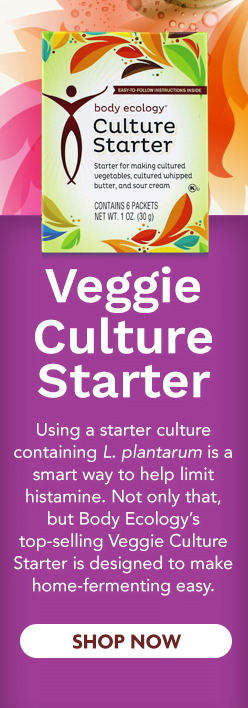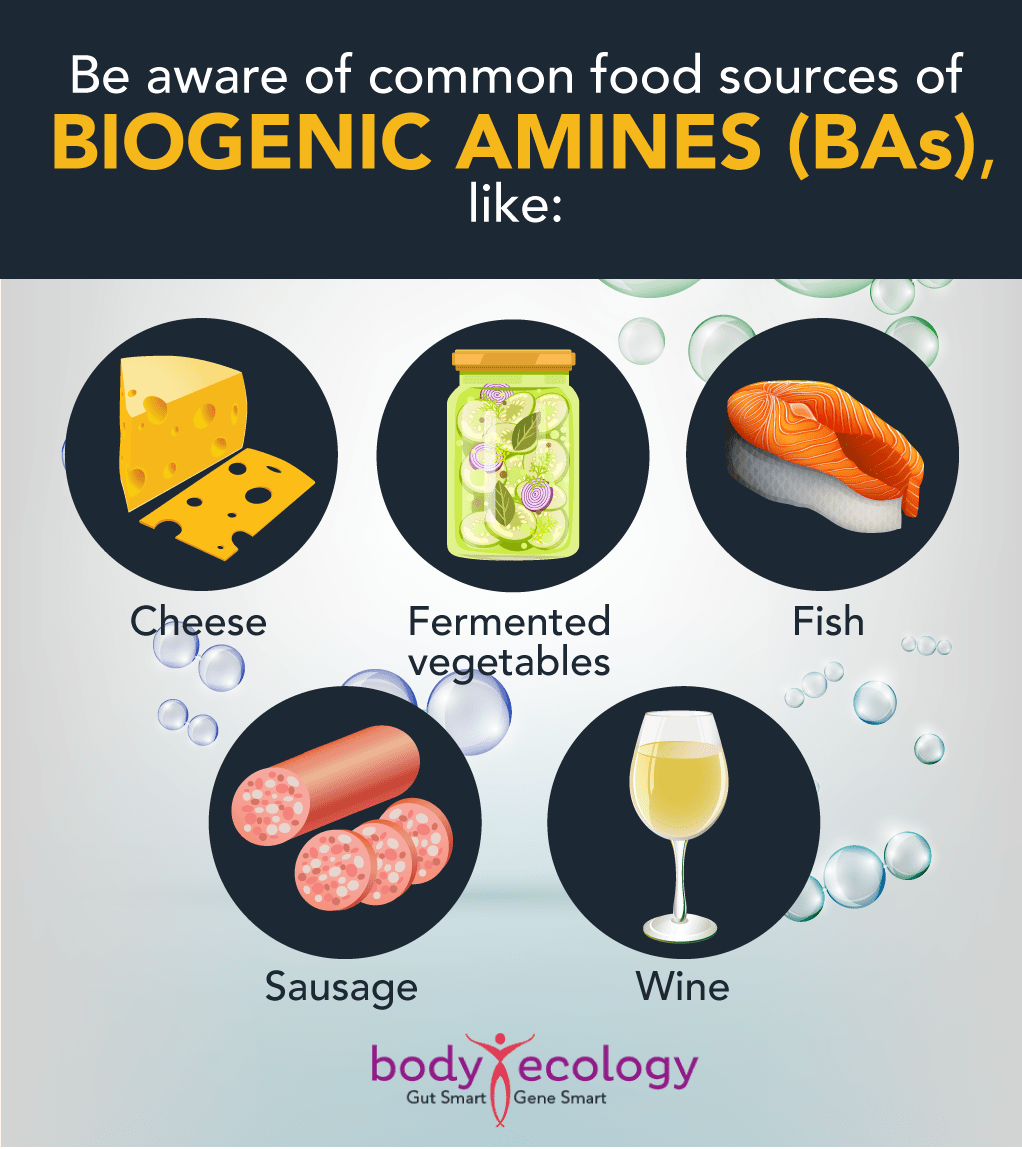
Having histamine problems? There’s something you need to know: Part 1
You probably know the effects of histamine all too well. Histamines are a biogenic amine that’s present in a wide range of foods.
 Never heard of biogenic amines? You’re not alone.
Never heard of biogenic amines? You’re not alone.
Biogenic amines (BAs) include histamine, spermidine, putrescine, and cadaverine and are produced from amino acids (the building blocks of protein). They form when foods start to “spoil” because of certain bacteria.
The biggest sources of biogenic amines are usually animal-derived foods that have been sitting out and are contaminated with bacteria. Some fermented foods also contain biogenic amines, though, which can quickly turn “health foods” into the cause of ill health.
Most of the time, your body can easily process these amines and stay healthy. But high levels of histamine and other amines, and a reduced detoxification capacity, can lead to unpleasant and sometimes even serious consequences.
What can you do about biogenic amines? You might already have the ideal solution on hand in your kitchen. That’s right — fermentation can be both a source of biogenic amines and the solution, which we look at here. First, though, let’s learn more about biogenic amines and the symptoms of histamine intolerance/overload.
Getting to know your amines

Some nuts and fresh fruits and vegetables also have higher levels of BAs, including citrus, bananas, strawberries, red prunes, pears, kiwi, raspberries, papaya, tomato, spinach, eggplant, avocado, mushrooms, and canned vegetables and prepared salads.
The worst culprits by far, though, are meats and fish, especially those that aren’t super-fresh. Histamine concentrations in tuna fillet in oil, tuna, and fresh yellowfin tuna loin are 4,398, 3,110, and 1,774 mg/kg, respectively.1 Scombroid food poisoning is known to occur after consuming fish products containing more than 1,000 ppm of histamine.2
Cheese can also be a major source of dietary BAs, with most cases of tyramine-related food poisoning seen when people eat cheese alongside pickled herring, meat products, avocados, soy sauce, miso, chicken livers, beef livers, and/or caviar.3
Exactly how your body handles histamine and other BAs
Under normal, healthy conditions:
- BAs are processed in the intestine by enzymes called amine oxidases.
- These include monoamine oxidase (MAO) and diamine oxidase (DAO), while histamine N-methyltransferase (HNMT) can also metabolize BAs.
- Eating a lot of BA-rich foods can overwhelm these enzymes, however.
- More than 40 mg of BAs per meal is thought to significantly increase the risk of food poisoning, for instance.4
Some people also have naturally lower levels of amine oxidase production, due to genetic factors or health issues that impair the MAO, DAO, and HNMT gene function and reduce the gut’s ability to keep on top of BA intake.5
Finally, some medications inhibit the activity of the MAO and DAO genes, while compounds in alcohol can reduce the effects of MAO and DAO, making wine and beer even more of a challenge to the body.6
It’s time to treat the cause and not just the symptoms. Register for Body Ecology’s Masterclass now.
Histamine intolerance 101: How much is too much?
Histamine, a biogenic amine, is created from the amino acid histidine. This can happen in food through the activity of enzymes like decarboxylase, but histamine is also produced naturally in your body. Why? Because it’s actually an important neurotransmitter.
Histamine is found in high concentrations in the hypothalamus (part of the brain), for example, and is involved in arousal and attention. If you take antihistamines that cross the blood-brain barrier, this explains why you may often experience a sedative effect.
Histamine is also produced by mast cells, which are part of the immune system. These cells release histamine in response to allergic reactions and tissue damage.
The intended purpose of histamine is to offer immediate, short-term, protective actions that can help prevent further damage.
The problem is that histamine production can quickly run amok, contributing to histamine intolerance and adding to histamine intake from the diet. Mast cells are also close to blood vessels, meaning that histamine can affect brain blood flow and lead to some serious symptoms of histamine intolerance/overload.7
Symptoms of excess BAs vary between individuals, depending on how much has been consumed and on a person’s general health and sensitivity.

A lot of these symptoms are related to histamine’s vasoactive properties.8 This means histamine causes blood vessels to spasm, which can lead to flushing, abdominal cramps, headache, and hypertension.9
In acute cases of food poisoning after consuming fish containing high amounts of histamine, symptoms can appear within minutes and up to three hours afterward and may include dizziness, faintness, burning sensation in the mouth, inability to swallow, and itching.10
Other amines, such as tyramine, phenylethylamine, and tryptamine, are mainly linked to hypertension, headache, pupil dilatation, and increased respiration.8
BA sensitivity is a tricky beast, with symptoms often overlooked because they can be so inconsistent. The same person could eat a certain food one day and have no symptoms, then eat the same food the next day and feel terribly unwell.
Why? Because of something called histamine load (more correctly, BA load).
Put simply, histamine load is a total measure of how much histamine you have in your body, regardless of whether this is from your diet or the histamine your body makes itself. If your histamine intake and production greatly outstrips your production of those key enzymes, the resulting high histamine load can trigger histamine intolerance and the symptoms above.
Just to reiterate, food isn’t the only cause of high histamine and histamine intolerance. Mold, pollen, fungal spores, and other factors can also increase histamine production in your body, meaning that even a low dietary intake of BAs could trigger symptoms.
What about bacteria and other microorganism-producing biogenic amines?
A whole host of microbes have the ability to produce biogenic amines. For the science geeks among us, they “decarboxylase” the amino acid, which removes the carboxyl group from the amino acid.
A few examples are found:
- In cheese – Yeasts, such as Debaryomyces hansenii and Yarrowia lipolytica, can produce histamine and tyramine.11
- In fermented soy products (miso, natto, sufu, douche) – Staphylococcus pasteuri, Bacillus amyloliquefaciens, Bacillus subtilis, and Bacillus megaterium in miso and Bacillus subtilis, Staphylococcus pasteuri, and Staphylococcus capitis can all produce biogenic amines.12-15
- In meat – Lactobacilli, Pseudomonads, Enterobacteriaceae, and Enterococci can produce biogenic amines.16-18
- In seafood (anchovies, tuna, mackerel, etc.) – Staphylococcus xylosus, Morganella morganii, Hafnia alvei, Klebsiella pneumoniae, and Aeromonas hydrophila can produce biogenic amines.19-21
- In wine – Lactobacillus sp. 30a and Lactobacillus sp. w53 produce histamine, putrescine, and cadaverine.22
- In yogurt – Streptococcus thermophilus can produce tyramine and histamine especially.23
Almost all of these microorganisms are more likely to increase in number and produce biogenic amines in food as the temperature increases. Some get a kickstart around 59 degrees Fahrenheit (15 degrees Celsius), while others get the party going full-swing at around 77 degrees Fahrenheit (25 degrees C).
Other things that can affect biogenic amine production include:
- The pH of the food or beverages. In other words, how acidic the conditions are. (Bacteria can’t grow in an acidic medium.)
- The general cleanliness of the storage conditions. Or, how clean the surrounding area is.
- The presence of salt and/or citric acid. These inhibit microbial growth.
- And — this is key! — other bacteria and microbes in the surrounding area.
In the second part of this series, we’ll look at ways to address histamine intolerance and reduce biogenic amines, including using our Body Ecology Culture Starter when fermenting foods at home.
REFERENCES:
- 1. Rapid Alert System for Food and Feed (RASFF). (2010). Annual Report 2010. Publications Office of the European Union. Luxembourg.
- 2. Luten, J., Bouque,W., Seuren, L., Burggraaf,M., Riekwel-Body, G., Durand, P., Etienne,M., Gouyo, J., Landrein, A., Ritchier, A., Leclerq, M. and Guinet, R. (1992). Biogenic amines in fishery products: Standardization methods within EC. In Quality assurance in the fish industry. pp 427–439. Huss, H., Ed. Elsevier Science Publishers.
- 3. Durak-Dados, A., Michalski, M., & Osek, J. (2020). Histamine and Other Biogenic Amines in Food. Journal of veterinary research, 64(2), 281–288. https://doi.org/10.2478/jvetres-2020-0029.
- 4. M.J.R. Nout, Fermented foods and food safety, Food Research International, Volume 27, Issue 3, 1994, Pages 291-298, ISSN 0963-9969, https://doi.org/10.1016/0963-9969(94)90097-3.
- 5. Alfred K. Anderson, Biogenic and volatile amine-related qualities of three popular fish species sold at Kuwait fish markets, Food Chemistry, Volume 107, Issue 2, 2008, Pages 761-767, ISSN 0308-8146, https://doi.org/10.1016/j.foodchem.2007.08.094.
- 6. Ancín-Azpilicueta C, González-Marco A, Jiménez-Moreno N. Current knowledge about the presence of amines in wine. Crit Rev Food Sci Nutr. 2008 Mar;48(3):257-75. doi: 10.1080/10408390701289441. PMID: 18274975.
- 7. Purves D, Augustine GJ, Fitzpatrick D, et al., editors. Neuroscience. 2nd edition. Sunderland (MA): Sinauer Associates; 2001. The Biogenic Amines.
- 8. Ali R. Shalaby, Significance of biogenic amines to food safety and human health, Food Research International, Volume 29, Issue 7, 1996, Pages 675-690, ISSN 0963-9969, https://doi.org/10.1016/S0963-9969(96)00066-X.
- 9. Stratton JE, Hutkins RW, Taylor SL. Biogenic Amines in Cheese and other Fermented Foods: A Review. J Food Prot. 1991 Jun;54(6):460-470. doi: 10.4315/0362-028X-54.6.460. PMID: 31051616.
- 10. Hungerford JM. Scombroid poisoning: a review. Toxicon. 2010 Aug 15;56(2):231-43. doi: 10.1016/j.toxicon.2010.02.006. Epub 2010 Feb 10. PMID: 20152850.
- 11. Gardini F, Tofalo R, Belletti N, Iucci L, Suzzi G, Torriani S, Guerzoni ME, Lanciotti R. Characterization of yeasts involved in the ripening of Pecorino Crotonese cheese. Food Microbiol. 2006 Oct;23(7):641-8. doi: 10.1016/j.fm.2005.12.005. Epub 2006 Feb 23. PMID: 16943063.
- 12. Hsien-Feng Kung, Yung-Hsiang Tsai, Cheng-I Wei, Histamine and other biogenic amines and histamine-forming bacteria in miso products, Food Chemistry, Volume 101, Issue 1, 2007, Pages 351-356, ISSN 0308-8146, https://doi.org/10.1016/j.foodchem.2005.12.057.
- 13. Hsien-Feng Kung, Yiing-Horng Lee, Shu-Chen Chang, Cheng-I. Wei, Yung-Hsiang Tsai, Histamine contents and histamine-forming bacteria in sufu products in Taiwan, Food Control, Volume 18, Issue 5, 2007, Pages 381-386, ISSN 0956-7135, https://doi.org/10.1016/j.foodcont.2006.02.012.
- 14. Yung-Hsiang Tsai, Shu-Chen Chang, Hsien-Feng Kung, Histamine contents and histamine-forming bacteria in natto products in Taiwan, Food Control, Volume 18, Issue 9, 2007, Pages 1026-1030, ISSN 0956-7135, https://doi.org/10.1016/j.foodcont.2006.06.007.
- 15. Yung-Hsiang Tsai, Hsien-Feng Kung, Shu-Chen Chang, Tsong-Ming Lee, Cheng-I Wei, Histamine formation by histamine-forming bacteria in douchi, a Chinese traditional fermented soybean product, Food Chemistry, Volume 103, Issue 4, 2007, Pages 1305-1311, ISSN 0308-8146, https://doi.org/10.1016/j.foodchem.2006.10.036.
- 16. Maijala R, Eerola S. Contaminant lactic acid bacteria of dry sausages produce histamine and tyramine. Meat Sci. 1993;35(3):387-95. doi: 10.1016/0309-1740(93)90043-H. PMID: 22061231.
- 17. Durlu-Özkaya F, Ayhan K, Vural N. Biogenic amines produced by Enterobacteriaceae isolated from meat products. Meat Sci. 2001 Jun;58(2):163-6. doi: 10.1016/s0309-1740(00)00144-3. PMID: 22062111.
- 18. Roig-Sagués, A., Eerola, S. Biogenic amines in meat inoculated with Lactobacillus sake starter strains and an amine-positive lactic acid bacterium. Z Lebensm Unters Forsch 205, 227–231 (1997). https://doi.org/10.1007/s002170050156.
- 19. Rodriguez-Jerez JJ, Mora-Ventura MT, Lopez-Sabater EI, Hernandez-Herrero M. Histidine, Lysine and Ornithine Decarboxylase Bacteria in Spanish Salted Semi-preserved Anchovies. J Food Prot. 1994 Sep;57(9):784-787. doi: 10.4315/0362-028X-57.9.784. PMID: 31121803.
- 20. Steve L. Taylor. Isolation of Histamine-Producing Bacteria From Frozen Tuna. MFR 45(4-6), 1983.
- 21. Middlebrooks BL, Toom PM, Douglas WL, Harrison RE, McDowell S (1988) Effects of storage time and temperature on the microflora and amine-development in Spanish mackerel (Scomberomorus maculatus). J Food Sci 53:1024–1029.
- 22. Pessione E, Mazzoli R, Giuffrida MG, Lamberti C, Garcia-Moruno E, Barello C, Conti A, Giunta C. A proteomic approach to studying biogenic amine producing lactic acid bacteria. Proteomics. 2005 Feb;5(3):687-98. doi: 10.1002/pmic.200401116. PMID: 15714464.
- 23. Gezginc Y, Akyol I, Kuley E, Özogul F. Biogenic amines formation in Streptococcus thermophilus isolated from home-made natural yogurt. Food Chem. 2013 May 1;138(1):655-62. doi: 10.1016/j.foodchem.2012.10.138. Epub 2012 Nov 10. PMID: 23265537.








